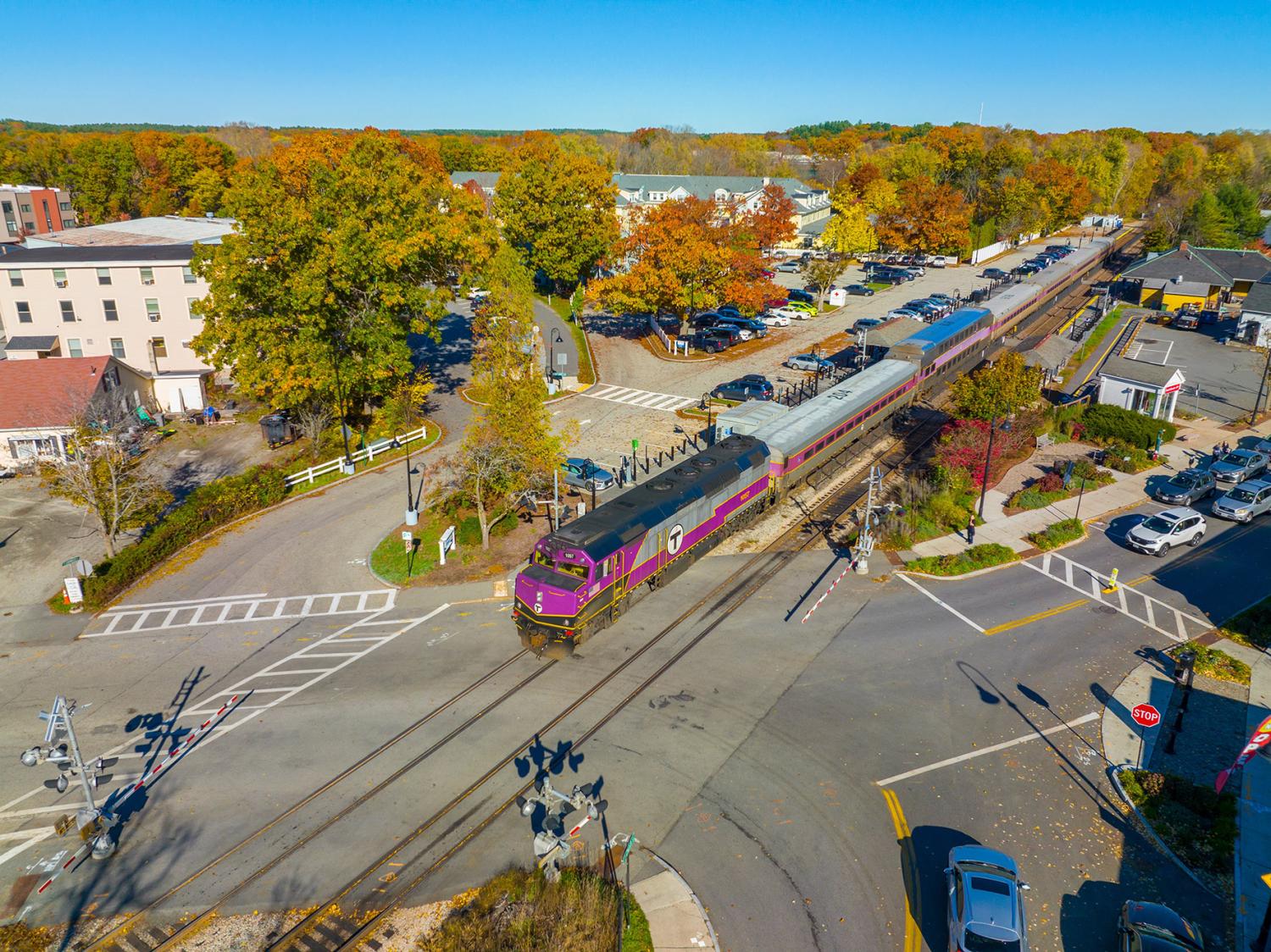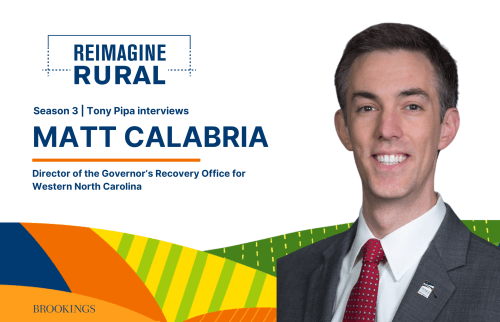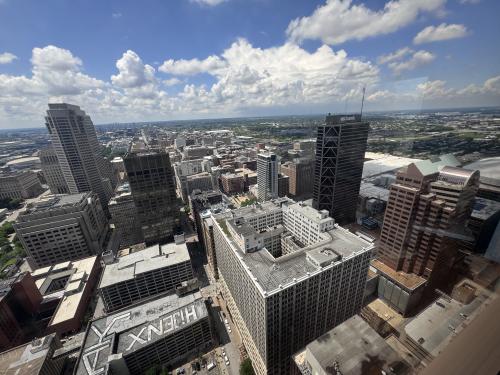Housing and transportation are the two largest expenses for most American households, together accounting for nearly half of monthly incomes. Building in location-efficient places—where roads, transit, and other infrastructure already exist—can lower both housing and transportation costs while also giving families the option to live in walkable, connected neighborhoods. The federal government already has powerful financing tools to support this kind of growth through the Transportation Infrastructure Finance and Innovation Act (TIFIA) and Railroad Rehabilitation and Improvement Financing (RRIF) programs, yet these are not designed to serve the smaller, more numerous transactions that define transit-oriented development.
Federal policymakers are also turning their attention to complementary strategies, such as converting underused commercial buildings into housing—often located in the same location-efficient areas near transit and existing infrastructure, where new housing can reduce both transportation and housing costs. In recent budget language, the Senate Appropriations Committee directed the Department of Housing and Urban Development (HUD) to identify federal barriers to office-to-residential conversions, evaluate innovative models such as co-living, and recommend changes to federal law to further incentivize such projects.
But removing barriers is only part of the equation. To fully realize the potential of location-efficient housing, federal transportation policy must also evolve to better align infrastructure investment with housing production. The next opportunity for this alignment comes as Congress considers the upcoming surface transportation reauthorization bill.
By making targeted reforms in the upcoming surface transportation reauthorization bill, Congress can unlock billions of dollars for transit-oriented housing projects that are currently stalled, enabling hundreds of thousands of new homes near transit at no additional cost to taxpayers.
Background
Building more homes near transit can lower transportation costs and boost disposable income for American families while also increasing transit ridership, strengthening local economies, and turning the trillions of dollars federal taxpayers have invested in public transit since 1964 into lasting value. Further, research shows that neighborhoods with more housing near job centers are associated with shorter commutes, as households are better able to live closer to where they work. With governments at all levels spending about $80 billion nationally every year to operate and expand their transit systems, we should make the most of these investments.
According to Freddie Mac, the U.S. faces a shortfall of approximately 3.7 million homes, driven by years of underbuilding relative to household formation. Meeting this need requires more housing of all types—affordable, workforce, and market rate—and in all kinds of locations, from established neighborhoods to new communities.
Yet much of the new development that does occur is on the urban outskirts, thus simply substituting lower housing costs in household budgets for higher transportation costs due to longer commutes. Such development also requires substantial taxpayer investment in new roads, utilities, and other infrastructure to serve dispersed growth.
One way to lower both housing and transportation costs without adding new taxpayer burdens is to build where roads, transit, and other infrastructure already exist. By building on underused land near transit, we can create vibrant, walkable neighborhoods that give people more affordable options for where to live and how to get around. Yet even in places where land, zoning, and infrastructure align, many promising projects never break ground because they cannot secure financing.
These projects often require layering multiple funding sources, covering higher upfront costs for structured parking and mixed-use design, and convincing lenders to back unconventional, multi-phase projects. For example, West Haven, Conn., created a transit-oriented development (TOD) district around its new commuter rail station in 2013, aiming to attract walkable, mixed-use projects. Over a decade later, little has been built; city officials say assembling financing has been a major barrier. West Haven is now seeking grants for site cleanup and pedestrian improvements to make the area more attractive to developers.
A similar story has played out in San Antonio, where a planned mixed-use TOD at the Scobey industrial site, adjacent to the city’s Centro Plaza transit hub, stalled after the developer backed out. Despite the site’s prime location and strong policy support, officials cited the complexity of financing large-scale, multi-use projects and uncertainty in the commercial lending market as key obstacles.
Traditional bank loan products often carry high interest rates and short repayment terms, but the federal government already has the financing tools and authority to bridge the gap by offering long-term, low-interest loans. By making a few key improvements to these lending programs, Congress can dramatically increase the amount of housing built near transit—all at no additional cost to taxpayers.
Originally created by Congress in 1998 to support large-scale transportation infrastructure, the TIFIA loan program and its sister program, the RRIF program, have since evolved into powerful tools with potential for financing mixed-use TOD. Managed by the Department of Transportation’s (DOT) Build America Bureau, both programs provide low-interest federal loans, loan guarantees, and lines of credit for eligible infrastructure and related development. Historically, these loans have primarily gone to public sector borrowers, including state and local governments, transit agencies, railroads, and special authorities, along with a small number of large private concessionaires. Since 1999, the program has committed $37.3 billion in capital expenditure loans—63% of that for highways and bridges, 31% for public transit, and the rest for rail or multimodal projects.
Over the years, Congress has made substantive changes to expand eligible projects: The FAST Act of 2015 first authorized TOD as an eligible project type, allowing TIFIA and RRIF loans to be used not just for transit stations and related infrastructure but also for certain development on adjacent land. The 2021 Infrastructure Investment and Jobs Act (IIJA) built on that by broadening eligibility to include a wider range of projects within a half-mile of transit—such as housing, retail, and other commercial infill—that improve access to transit and make better use of the surrounding land. In 2021, the Build America Bureau issued guidance implementing these statutory changes and incorporating recommendations from the Government Accountability Office (GAO), formally clarifying how vertical, mixed-use development near transit can qualify.
Despite expanded eligibility, TIFIA and RRIF are not yet structured to serve the smaller, more numerous transactions that define transit-oriented development. A $25 million TOD loan request must go through the same intensive credit review, environmental analysis, and closing steps required for a $400 million toll road. As part of that process, DOT requires applicants to reimburse external financial and legal advisors, which typically range from $400,000 to $700,000—making it more difficult for smaller projects to be financially viable.
Knowledge-sharing with potential borrowers is another concern. Most private real estate developers, who lead many TOD projects, have had limited direct interaction with these programs, which were designed with public infrastructure sponsors in mind. For developers, the programs’ investment-grade credit requirements, complex federal compliance obligations, and infrastructure-centric eligibility criteria have made accessing this capital more challenging.
Even with limited market awareness, the Build America Bureau isn’t set up for administrative success. As the volume of TOD applications grows, Bureau staff could become overwhelmed by transaction counts, understandably diverting finite attention and focus toward larger infrastructure projects that more fully utilize available appropriations with current staffing resources, at the expense of relatively smaller TOD project loans.
Yet these two programs are poised to do much more. TIFIA continues to retain meaningful unused lending authority: As recently as FY 2018, there was $1.65 billion in unobligated subsidy authority, and the October 2024 TIFIA at 25 Retrospective confirmed that carryover balances remain in place, indicating the program continues to have fiscal firepower to support both large infrastructure projects and a healthy pipeline of smaller TOD projects. The constraint, therefore, is administrative, not financial. This pattern underscores the need for tailored enhancements if we want to unlock TIFIA’s financing tools for smaller-scale TOD transactions.
With a few simple improvements, Congress can make these programs even more useful for bridging the financing gap to unlock more housing near transit without new taxpayer spending. Here are three big ideas to unlock TIFIA and RRIF’s potential for transit-oriented development.
Delegate origination and servicing to certified private lenders
To enhance the efficiency and reach of the TIFIA and RRIF programs, Congress should authorize—and DOT should implement—a delegated lending model akin to the Federal Housing Administration’s 221(d)(4) program for multifamily housing, the Small Business Administration’s 7(a) loan program, the Department of Agriculture’s Business and Industry Loan Guarantees program, and the Export-Import Bank’s Loan Guarantee program. In these delegated models, approved private lenders originate, underwrite, and service loans according to federal program guidelines, while the federal agency retains ultimate oversight.
Under this approach, Congress would establish clear statutory parameters for risk-sharing, including underwriting standards, capital reserve requirements, and default thresholds. DOT and the Build America Bureau would retain portfolio-level oversight, periodic audit authority, and the ability to suspend or disqualify lenders for noncompliance—but would not re-underwrite individual loans. This ensures that federal oversight protects taxpayers while allowing private lenders to apply market discipline and take on risk consistent with commercial real estate lending practices.
Programs such as the 221(d)(4) and 7(a) demonstrate that delegated lending can successfully balance federal risk management with private sector efficiency. They provide useful models for certifying lenders, defining credit criteria, and maintaining oversight without undermining scalability or transaction speed.
To further calibrate risk tolerances, Congress could direct DOT to launch a limited pilot program to test default rates, administrative efficiency, and lender performance before full-scale implementation. Lessons from the pilot could then inform permanent statutory parameters and program design.
By involving private lenders directly in the loan process, this model ensures that private capital and market discipline are integral to project financing, while also maintaining federal credit safeguards.
In sum, delegating these functions would leverage private sector expertise, reduce processing times, accelerate the financing of housing and mixed-use development near transit, and strengthen financial safeguards alongside federally backed loans while crowding in additional private capital.
Leverage TIFIA to capitalize and scale regional TOD funds
States already may apply for and receive a single TIFIA loan to capitalize a special account they set aside for rural projects in their state infrastructure bank. This “pooled loan” approach, authorized under current law, allows multiple small projects—such as fixing bridges, upgrading small airports, or even building transit-friendly housing in small towns—to be bundled into one financing agreement, minimizing transaction costs and speeding up approvals. The Build America Bureau’s master credit agreement authority works in a similar way, allowing DOT to commit a total dollar amount for a package of related projects, with individual loans issued as projects are ready.
Packaging multiple projects into one financing agreement cuts down on repetitive approvals, leverages states’ local market knowledge and underwriting practices, and frees up Bureau staff to focus on larger infrastructure commitments. These tools share the same core principle: Approve the financing framework once, then fund multiple eligible projects over time under that framework. The same approach could be applied to create a pooled transit-oriented development loan fund, capitalized by a TIFIA loan, to finance a portfolio of station-area and infill housing projects. And with targeted statutory changes, Congress can make it far easier and more efficient to deploy this model nationwide.
A single TIFIA or RRIF loan—for example, $300 million—could capitalize the fund and align TOD funding with the program’s typical loan size of $380 million. The fund would provide low-interest financing to qualifying projects, and use the proceeds from those loans to repay the federal loan over time under the negotiated amortization schedule and interest rate. DOT would maintain approval of the fund’s overall framework and annual reporting, but delegate individual project-level decisions to the fund. DOT could go further by encouraging “blind pool” master credit agreements (MCAs), where a single financing commitment is made for a portfolio of not-yet-specified TOD projects, and individual projects draw on that commitment as they are identified and meet all TIFIA requirements. This approach would let smaller projects move forward over time under one approval framework while preserving TIFIA’s credit safeguards and administrative capacity.
Congress could adapt and expand these pooled loan and blind pool tools to support a dedicated TOD fund, making targeted changes to TIFIA’s statute to ensure an MCA or similar structure can efficiently finance a portfolio of station-area and infill housing projects. Specifically, Congress could:
- Clarify TIFIA eligibility for transit-oriented development by explicitly referencing TOD in the eligible project definitions. While current law already allows certain TOD projects through its “joint development” provision, naming TOD directly would provide clearer direction to DOT, give applicants greater confidence, and normalize the use of TIFIA for housing and mixed-use projects near transit.
- Exempt environmental reviews for small, low-impact projects.
- Clarify that minimum project size, creditworthiness, and security requirements may be met at the program level rather than project by project. Current law already allows the minimum project size, creditworthiness, and security requirements to be met at the program level for projects grouped under a common security pledge within an MCA. DOT could clarify through guidance that these requirements apply to the overall program rather than to each project individually, so long as all sub-projects meet applicable environmental and eligibility standards before drawing on the MCA.
- Authorize revolving or evergreen MCAs, allowing loan repayments or unused authority to be recycled into new projects. This would transform the blind pool model into a construction financing revolving loan fund, similar to the successful state revolving funds used for decades to finance water and wastewater infrastructure, and are capitalized in part by federal grants and then sustain themselves over time through repayments of principal and interest. Like those funds, a revolving TOD master credit agreement would enable a single master facility to finance multiple waves of TOD projects over time, addressing one of the most challenging credit access points in the market—the availability of affordable construction financing—while maintaining TIFIA’s strong credit safeguards.
- Authorize delegated project-level approvals to a qualified state infrastructure bank, regional agency, or other designated public entity. Under current law, the secretary of transportation, acting through the Build America Bureau, must make the final determinations on each individual TIFIA loan’s creditworthiness, eligibility, and compliance with statutory requirements. This authority cannot be delegated to a non-federal entity. A statutory change could allow DOT to approve the fund’s framework up front while the managing entity handles underwriting, compliance, and final approval for individual projects within that framework.
Together, these reforms would allow Congress to adapt and expand TIFIA’s pooled loan tools into a dedicated national TOD fund, giving communities a reliable and scalable way to finance station-area and infill housing projects.
Streamline National Environmental Policy Act reviews for TOD projects
Even with stronger financing tools in place, one of the most significant barriers to timely use of TIFIA for transit-oriented development is the way National Environmental Policy Act (NEPA) reviews are applied when federal funds are involved. In addition to the legislative actions above, DOT could act administratively to improve efficiency by allowing a single NEPA review and creditworthiness assessment to apply to the entire pool, rather than repeating the process for each individual project. This change could be implemented under existing authority and would further reduce costs and timelines for bringing TOD projects to market.
One of the most significant barriers to timely use of TIFIA for transit-oriented development is the way NEPA reviews are applied when federal funds are involved. Many TOD projects would not ordinarily require NEPA review if financed solely with private or local dollars. But once TIFIA or other federal programs are used, a NEPA review is triggered, even for projects with minimal environmental impacts, such as redevelopment in already urbanized areas. This can add years of delays and millions of dollars in costs, in some cases deterring local governments and developers from using federal financing altogether.
Streamlining NEPA reviews in this context does not mean waiving environmental protections—it means calibrating the level of review to the actual impacts of the project. For example, applying a single programmatic NEPA review to a pool of TOD projects rather than repeating the process for each individual project would maintain safeguards while saving time and resources.
Even more effective would be a narrowly drawn statutory NEPA exemption for low-impact categories of TOD, such as urban infill developments, where the environmental benefits of reduced sprawl and vehicle use are clear. Such a statutory exemption would provide the strongest path to accelerated delivery, cutting years off project timelines while maintaining appropriate environmental safeguards for high-impact developments.
By aligning financing tools with streamlined environmental review, Congress could enable pooled TOD funds to provide low-interest financing to qualifying projects, use loan repayments to retire the federal debt under negotiated terms, and unlock more location-efficient housing near transit—all while preserving the Build America Bureau’s capacity to manage large-scale infrastructure commitments.
Remove TIFIA’s investment-grade credit rating requirement
Current law requires most TIFIA loans to obtain an investment-grade rating from a nationally recognized credit rating agency before closing. This requirement reflects the fact that TIFIA was initially a tool for financing large, revenue-generating government infrastructure projects such as toll roads and major transit lines.
But the investment-grade rating requirement is a poor fit for smaller-scale residential and mixed-use developments near transit. Often, rating agencies will not rate these projects at all because they are small, complex, and lack the single, dedicated revenue stream—ideally with a historic performance record—that infrastructure rating methodologies rely on. For these projects to secure a rating would typically require a guarantee from an entity with an existing investment-grade rating, such as a municipality or housing authority. These entities generally have the ability to issue tax-exempt municipal debt at interest rates competitive with or even lower than the TIFIA rate, which blunts the financial advantage of using a TIFIA loan. In addition, providing such a guarantee can negatively affect their debt service guarantee ratios and increase their contingent liabilities, creating further disincentives to participate. On top of that, obtaining a rating can cost hundreds of thousands of dollars and add months to the timeline—delaying groundbreaking and increasing carrying costs.
Removing the investment-grade rating requirement for residential and mixed-use TOD projects would align TIFIA’s underwriting process with the scale and nature of these transactions and make it more consistent with the RRIF program, which relies on rigorous internal credit assessments rather than a formal rating. Congress could maintain strong risk management standards by allowing credit assessments to be conducted internally by Build America Bureau staff, similar to how other federal loan programs function, including RRIF, the Environmental Protection Agency’s Water Infrastructure Finance and Innovation Act program, the Department of Agriculture’s Community Facilities Direct Loan and Grant Program, and HUD’s Section 108 Loan Guarantee Program.
All of these programs rely on robust internal underwriting processes to safeguard public funds without requiring a rating from a nationally recognized credit rating agency. Adopting a similar approach for TIFIA transit-oriented development projects would remove a structural barrier, reduce transaction costs, accelerate approvals, and broaden access to affordable, scalable financing for development near transit.
Conclusion
The ideas explored in this report would transform the Build America Bureau’s TOD lending program from a high-barrier program for small loans into a catalytic tool for fiscally responsible, community-led growth. Congress should adopt these reforms as part of the next surface transportation reauthorization bill, due in 2026. If adopted, these tools could enable the Bureau to unlock a larger share of its TIFIA and RRIF lending capacity. Already, project sponsors representing approximately $10 billion in potential TOD deals have expressed interest in these programs, but have an uncertain path to receive support from DOT due to financing barriers and institutional capacity limitations.
If Congress enacted the reforms discussed above, it would move forward these and many other projects that otherwise would not pencil out in today’s higher interest rate environment. These tools could enable communities across the country to build hundreds of thousands of new homes and expand housing choices so that people can afford to live in walkable neighborhoods. And since these loans are repaid with interest, it’s not just fiscally responsible—it’s a smart, revenue-generating investment in America’s future.
-
Acknowledgements and disclosures
The authors thank Tracy Hadden Loh, Robert Puentes, and Adie Tomer for their review of earlier drafts of this piece. Any remaining errors or omissions are those of the authors.
This research was generated with support from Arnold Ventures. The views expressed in this feature are those of its authors and do not reflect the views of the donors, their officers, or employees.
The Brookings Institution is committed to quality, independence, and impact.
We are supported by a diverse array of funders. In line with our values and policies, each Brookings publication represents the sole views of its author(s).





